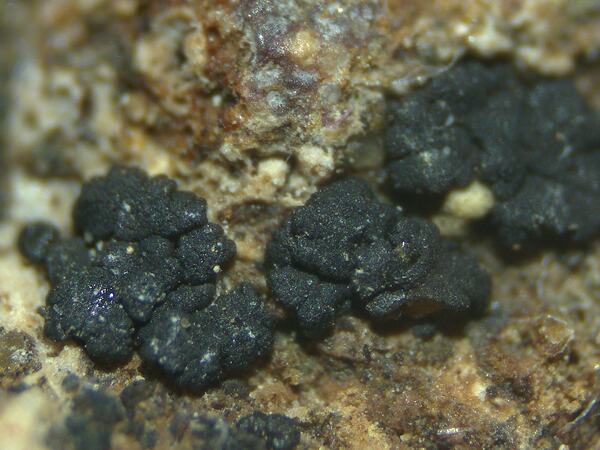Lichinella algerica (J. Steiner) P.P. Moreno & Egea
Cryptogamie Bryol.-Lichénol., 13, 3: 241, 1992. Basionym: Gonohymenia algerica J. Steiner - Verh. zool.-bot. Ges. Wien, 52: 485, 1902
Synonyms: Thyrea pitardi (Harm.) Zahlbr.
Distribution:
Description: Thallus squamulose-umbilicate, gelatinous when wet, black, the squamules scattered to clustered but never forming dense aggregations, adnate to slightly ascending, 3-4 mm wide, smooth or weakly granulose, with an entire or weakly incised margin when young, later lobulate; lower surface attached by a central holdfast. Outer part of squamules (in section) formed by 1.5-2 µm thick, mainly anticlinally oriented hyphae enclosing the photobiont cells, the medullary part of loosely arranged, 1-1.5 µm thick hyphae with cylindrical cells, the central part with a dense strand of irregularly arranged hyphae connecting the subhymenium with the basal attachment strand, the cells progressively enlarged towards the base, the last ones 4-5 µm wide. Apothecia thallinocarps, hemiangiocarpous, the ascogonia arising freely beneath the thallus surface, sunken in thallus and difficult to recognize unless when wet, up to 1.5 mm across, round to irregularly shaped, with a flat to slightly convex, fissured disc. Proper exciple indistinct; epithecium brownish; hymenium 90-130 µm high, not separated into partial hymenia, covered by a irregularly thick layer of sterile tissue and a layer of photobiont cells, K/I+ blue turning wine-red; paraphyses 3-4 µm thick, not constricted at septa nor capitate; subhymenium compact, 20-30 µm high. Asci 16-32-spored, subcylindrical to obclavate, prototunicate, with a thin, one-layered, non-amyloid wall, an amyloid external apical cap, and passive spore discharge via apical rupturing, Lichina-type, 70-95 x 10-15 µm. Ascospores 1-celled, hyaline, broadly ellipsoid to subglobose, 5-7(-9) x (2-)3-5 µm. Pycnidia globose to broadly pyriform, immersed, unilocular, up to 60-110 µm wide. Conidia ellipsoid, 2-4 x 1-1.5 µm. Photobiont cyanobacterial, chroococcoid, with clusters of 4-8 cells measuring 5-10 x 5-7 µm penetrated by haustoria and surrounded by a brownish gelatinous sheath. Spot tests: all negative. Chemistry: without lichen substances.Note: a species of dry areas, known from the Canary Islands, NE Africa, the SE part of the Iberian Peninsula and the Middle East, extending into the steppe-zone up to Mongolia, found on steeply inclined, sunny surfaces of siliceous rocks with periodical seepage of water after rain. To be looked for in the driest parts of Mediterranean Italy.
Growth form: Squamulose
Substrata: rocks
Photobiont: cyanobacteria, coccaceous (e.g. Gloeocapsa)
Reproductive strategy: mainly sexual
On otherwise dry surfaces with short periods of water seepage after rain

Predictive model
Growth form: Squamulose
Substrata: rocks
Photobiont: cyanobacteria, coccaceous (e.g. Gloeocapsa)
Reproductive strategy: mainly sexual
On otherwise dry surfaces with short periods of water seepage after rain

Predictive model
 Index Fungorum
Index Fungorum
 GBIF
GBIF





